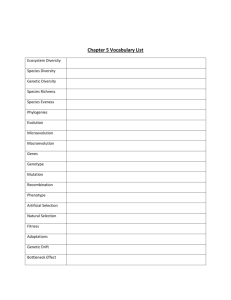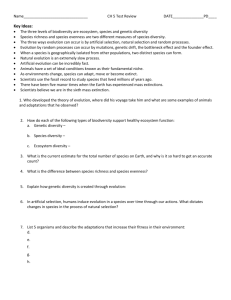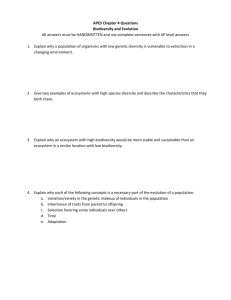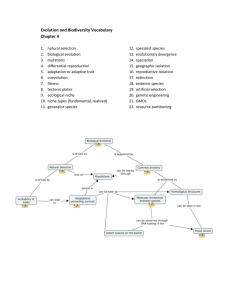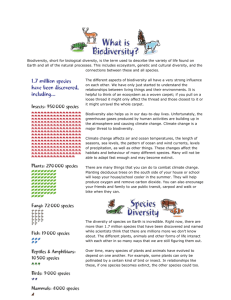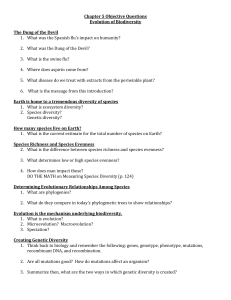Chapter 4
advertisement
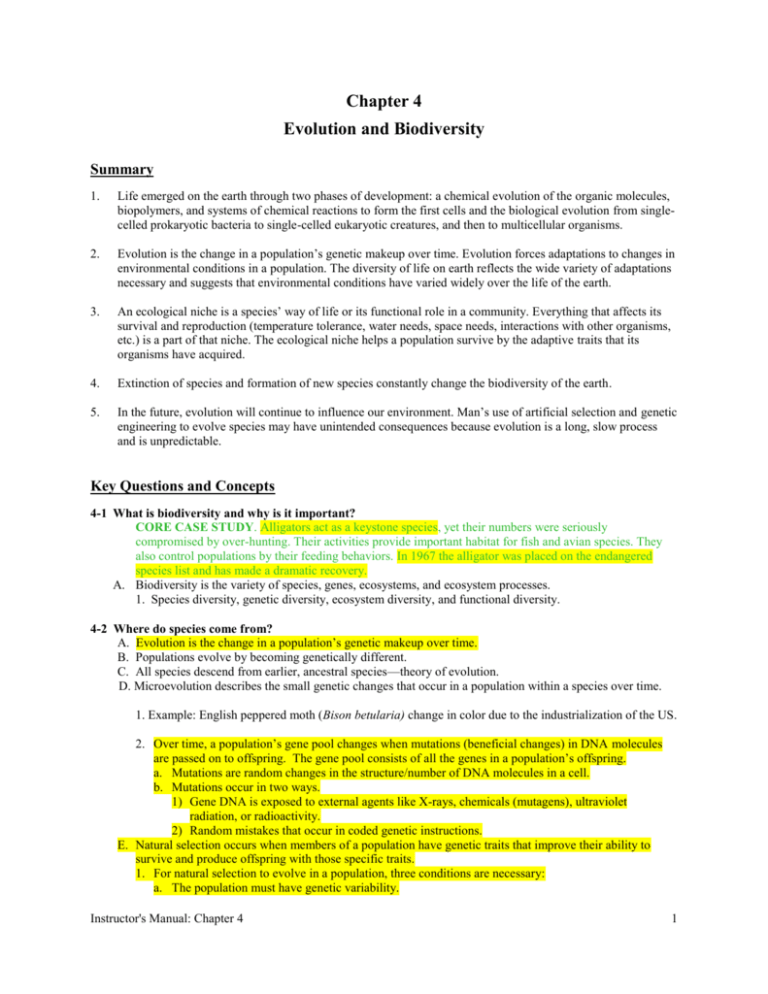
Chapter 4 Evolution and Biodiversity Summary 1. Life emerged on the earth through two phases of development: a chemical evolution of the organic molecules, biopolymers, and systems of chemical reactions to form the first cells and the biological evolution from singlecelled prokaryotic bacteria to single-celled eukaryotic creatures, and then to multicellular organisms. 2. Evolution is the change in a population’s genetic makeup over time. Evolution forces adaptations to changes in environmental conditions in a population. The diversity of life on earth reflects the wide variety of adaptations necessary and suggests that environmental conditions have varied widely over the life of the earth. 3. An ecological niche is a species’ way of life or its functional role in a community. Everything that affects its survival and reproduction (temperature tolerance, water needs, space needs, interactions with other organisms, etc.) is a part of that niche. The ecological niche helps a population survive by the adaptive traits that its organisms have acquired. 4. Extinction of species and formation of new species constantly change the biodiversity of the earth. 5. In the future, evolution will continue to influence our environment. Man’s use of artificial selection and genetic engineering to evolve species may have unintended consequences because evolution is a long, slow process and is unpredictable. Key Questions and Concepts 4-1 What is biodiversity and why is it important? CORE CASE STUDY. Alligators act as a keystone species, yet their numbers were seriously compromised by over-hunting. Their activities provide important habitat for fish and avian species. They also control populations by their feeding behaviors. In 1967 the alligator was placed on the endangered species list and has made a dramatic recovery. A. Biodiversity is the variety of species, genes, ecosystems, and ecosystem processes. 1. Species diversity, genetic diversity, ecosystem diversity, and functional diversity. 4-2 Where do species come from? A. Evolution is the change in a population’s genetic makeup over time. B. Populations evolve by becoming genetically different. C. All species descend from earlier, ancestral species—theory of evolution. D. Microevolution describes the small genetic changes that occur in a population within a species over time. 1. Example: English peppered moth (Bison betularia) change in color due to the industrialization of the US. 2. Over time, a population’s gene pool changes when mutations (beneficial changes) in DNA molecules are passed on to offspring. The gene pool consists of all the genes in a population’s offspring. a. Mutations are random changes in the structure/number of DNA molecules in a cell. b. Mutations occur in two ways. 1) Gene DNA is exposed to external agents like X-rays, chemicals (mutagens), ultraviolet radiation, or radioactivity. 2) Random mistakes that occur in coded genetic instructions. E. Natural selection occurs when members of a population have genetic traits that improve their ability to survive and produce offspring with those specific traits. 1. For natural selection to evolve in a population, three conditions are necessary: a. The population must have genetic variability. Instructor's Manual: Chapter 4 1 b. The trait must be heritable, capable of being passed from one generation to another. c. The trait must enable individuals with the trait to produce more offspring than individuals without the trait; this is differential reproduction. 2. Adaptation or adaptive traits are heritable traits that help organisms to survive and reproduce better under prevailing environmental conditions. CASE STUDY. Humans have thrived so well as a species because of their strong opposable thumbs, ability to walk upright and complex brain. These adaptations may not prove as beneficial as the environment continues to change, though our powerful brain may allow us to live more sustainably in the future. H. Convergent Evolution: Species form different evolutionary branches (taxonomic groups) may come to resemble each other if they if they live in very similar environments. Example: 1. Ostrich (Africa) and Emu (Australia). 2. Sidewinder (Mojave Desert) and Horned Viper (Middle East Desert) I. Natural selection can only act on existing genes and is limited by reproductive capacity. J. Three Types of Natural Selection a) Directional natural selection: Shifts towards one end of a normal range b) Stabilizing natural selection: Shifts toward the intermediate phenotype, the extreme forms are eliminated. c.) Disruptive (diversifying) natural selection: shifts away from the intermediate, the extreme forms of the trait become more dominant K. Co evolution: it is an evolution in which two or more species interact and exert selective pressures on each other that can lead each species to undergo various adaptations. Change in the gene pool of one species effects the change of the gene pool of another species. a) One species acts as selective force on a second species b) Examples: Wolf and Moose, Acacia ants and Acacia trees, Yucca plants and Yucca moths. L. Macroevolution is concerned with how evolution takes place above the level of species and over much longer periods than microevolution, and macro evolutionary patterns includes genetic persistence, genetic divergence, and genetic loss. M. Evolution is concerned with leaving the most descendants, NOT the strongest ones. N. There is no master plan to achieve genetic perfection. 4-3 How do geologic processes and climate change affect evolution? A. Processes such as the shifting of tectonic plates, volcanic eruptions, and earthquakes influence earth’s climate and in turn affect evolution by removing and/or isolating habitats and species. B. Long-term climate changes relocate ecosystems, thus determining where certain species can live. C. Asteroids and meteorites have caused environmental stress and mass extinctions. SCIENCE FOCUS: the conditions that make Earth suitable for life. The Just Right Planet Life as we know it depends on liquid water. The earth’s orbit is the right distance it spins, otherwise one side would be too hot and the other side to cold. Right size- enough gravitational mass to keep its iron and nickel core molten and to keep the light gaseous molecules in its atmosphere from flying off to space. Oxygen 21%- of the volume of earth’s atmosphere, if it was 15% it would be lethal to most life forms, at 25% the atmosphere would probably ignite into a giant fireball. Ozone protects us from harmful ultraviolet radiation. 4-4 How do speciation, extinction, and human activities affect biodiversity? A. Natural selection can lead to development of an entirely new species. In speciation, two species arise from one when some members of a population cannot breed with other members to produce fertile offspring. Speciation occurs in two phases: 1. Geographic isolation, physical separation for long time periods. May result from volcanic eruptions, earthquakes, mountain range, or roads 2. Reproductive isolation. B. When population members cannot adapt to changing environmental conditions, the species becomes extinct. SCIENCE FOCUS: Artificial ways to control population genetics include artificial selection and genetic engineering. 2 Evolution and Biodiversity C. The Earth’s biodiversity is decreasing because of human activities. 1. Evidence supports that there have been 5 mass extinction (25-70% of species going extinct) in the history of the Earth. 4-5 What is species diversity and why is it important? A. Species diversity is the number of species (richness) combined with their relative abundance (evenness). B. Species rich communities tend to be more stable and more productive. C. Biodiversity equals speciation minus extinction SCIENCE FOCUS: the size of a habitat affects the species richness of that habitat island D. The number of species on an island is determined by how fast new species arrive, how fast old species become extinct, the size of the island, and the distance from the mainland. 1. The species equilibrium model, or the theory of island biogeography, was proposed in the 1960s to explain differences in species richness with island size. a. Balance between two factors is important in this model: rate of immigration of species and rate of extinction of existing species. b. Two island features are important: size and distance from mainland c. The larger the island and the closer it is to the mainland the more diverse it will be.. 2. This model has been expanded to include habitat islands in protected areas such as national parks. 4-6 What roles do species play in ecosystems? A. Ecological niche is a species’ way of life in an ecosystem, everything that affects its survival and reproduction. 1. The niche includes the members’ adaptations; its range of tolerance for physical and chemical conditions, its interactions with other components of the ecosystem, types of predators, the type of resources required and its role in energy flow and matter recycling. 2. The fundamental niche is the full potential range of conditions and resources a species could potentially use. Its realized niche is the part of the potential niche that allows a species to survive and avoid competition with other species for the same resources. 3. This is NOT the same as the organism’s habitat. 4. Niche is the specie’s job (role) and its habitat is its address 5. The habitat is the physical location where a species lives B. Some species have broad ecological roles and are termed generalist species. C. Some species have narrow ecological roles and are termed specialist species. They are more likely to become extinct because they don’t adapt well and have a limited range of tolerance for food and environment. Example: Giant Panda Bear D. Species can be classified as generalist or specialist based on their range of tolerance, niche, limiting factors, and response to change. CASE STUDY. Cockroaches are the ultimate generalists. The can survive extreme conditions and have a wide variety of adaptations that allow them to avoid predation. By contrast, many species are narrow specialists, though they sometimes have an advantage in their environment because they have few competitors. D. Niches can be occupied by native or non-native species. E. Indicator species provide early warning of ecosystem damage because they have a narrow range of tolerance. 1. Examples of indicator species a. Trout in water with a specific temperature requirement b. Birds that need a large forested area c. Frogs that take in water and air through their skin d. Butterflies that use specific plants as food CASE STUDY. Amphibians are indicator species that are declining globally. Factors affecting their survival include habitat loss, drought, pollution, increase in UV radiation, parasites, fungal diseases, climate change, overhunting, and introduction of non-native species. Their role as indicator species is cause for alarm on a global scale. H. Keystone species have a large affect on maintaining balance within an ecosystem. 1. Can be, but are not necessarily, pollinators and top predators. Instructor's Manual: Chapter 4 3 a. Sea otters, dung beetles, gopher tortoises grey wolves are all examples of Keystone species 2. Foundation species create and enhance habitats that benefit other species. Example: elephants, kelp, coral CASE STUDY. Sharks are keystone species that have been overlooked by conservation efforts because of human bias. They tend to be considered dangerous and have gone without protection despite being heavily fished for their valuable fins. They also commonly drown in fishing nets. Shark populations have been declining since the 1970s, and scientists are now calling for a ban on shark finning in international waters. 4 Evolution and Biodiversity


